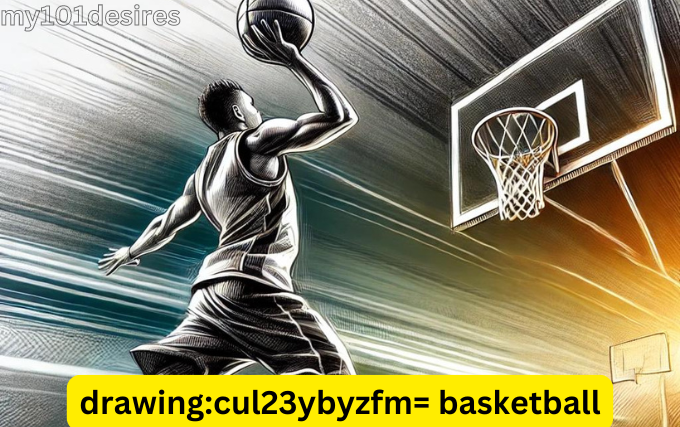Creating sports-related artwork has always been a thrilling experience for many artists. One of the most popular subjects is basketball, a sport known for its high energy, fast-paced movements, and captivating moments. This article will guide you on how to approach drawing basketball scenes, focusing on techniques, tools, and tips to make your artwork dynamic and engaging.
Why Draw Basketball?
Basketball offers artists an opportunity to capture movement, emotion, and intensity. The fast breaks, slam dunks, and strategic plays in a basketball game can translate into a compelling piece of art. By using the keyword “drawing
= basketball,” you can explore various aspects of basketball that can enhance the artistic value of your work.
Benefits of Drawing Sports Art
- Enhances Observation Skills: Drawing live-action sports like basketball helps in improving your attention to detail. You observe how players move, how light affects the scene, and the overall atmosphere of the game.
- Captures Emotion: Every game is filled with emotion, and basketball is no exception. From the determination on a player’s face to the excitement of the crowd, these emotions can be captured through your artwork.
- Improves Drawing Technique: Sports like basketball provide a range of poses, stances, and movements that will challenge and refine your drawing skills.
Materials Needed to Draw Basketball Art
Drawing Pencils and Charcoal
One of the best tools for sketching basketball scenes is a set of drawing pencils and charcoal. Pencils help with light sketches and defining details, while charcoal is great for creating contrast, shadows, and dynamic effects. By incorporating the keyword “drawing
= basketball,” you can experiment with different tools to highlight various elements like players, basketball courts, and equipment.
Paper
High-quality paper can make a big difference in how your artwork turns out. For basketball sketches, use a smooth-textured paper that can handle shading and detail work without smudging too much.
Digital Tools
If you prefer digital art, there are many programs like Adobe Illustrator and Procreate that allow for a detailed and vibrant depiction of basketball scenes. You can use layers, textures, and brush settings to create realistic effects. “Drawing
= basketball” works well for digital tools, as you can explore various techniques that might be difficult to achieve with traditional materials.
Steps to Drawing a Basketball Scene
Step 1: Observation and Reference
The first step to drawing a realistic basketball scene is observation. Watch basketball games, study how players move, and capture the key moments. Using reference photos or even watching slow-motion replays of iconic plays can help you break down the scene.
Step 2: Start with Basic Shapes
When drawing basketball scenes, start by sketching the basic shapes of the players and the court. Focus on proportion and position. For instance, the body should be proportionate to the basketball, and the player’s movement should reflect the dynamics of the game.
Step 3: Add Details
Once the basic shapes are in place, begin adding details. Focus on the facial expressions, muscles, clothing, and the basketball itself. Using the keyword “drawing
= basketball” can give you inspiration on how to include unique details like sweat, light reflections, or even the texture of the basketball.
Step 4: Shading and Highlights
Shading is essential to bring your basketball drawing to life. Use soft pencils or digital shading tools to create depth. Pay attention to the direction of light and where the shadows fall. Highlight the areas where the light hits the player or the basketball, giving the drawing a more three-dimensional feel.
Common Challenges in Drawing Basketball Scenes
Proportions
It can be difficult to get the proportions right when drawing fast-moving sports scenes. Basketball players are often in action, jumping or sprinting, which requires careful attention to detail. Practice drawing different poses to improve your ability to capture movement accurately.
Dynamic Movements
Basketball is full of action. From slam dunks to three-pointers, the movements can be challenging to draw. Focus on the flow of the body and how each part of the player’s body moves in relation to the ball
Capturing Energy
One of the hardest aspects of drawing drawing:cul23ybyzfm= basketball is capturing the energy of the game. You want your audience to feel the intensity of the moment. This is where contrast, shading, and careful detailing come in. Using the keyword “drawing
= basketball” as a guide can help you focus on the most exciting parts of the game and highlight them in your artwork.
Tips for Improving Your Basketball Drawings
- Practice Anatomy: The more you understand human anatomy, the better you’ll be at drawing realistic drawing:cul23ybyzfm= basketball players. Study the muscles, joints, and movement patterns to bring more accuracy to your art.
- Watch Basketball Games: Immerse yourself in the sport. The more you watch basketball, the easier it becomes to capture its essence in your drawings.
- Experiment with Perspective: To make your drawing:cul23ybyzfm= basketball drawings stand out, try drawing from different angles, such as a low-angle shot or a top-down view of the court.
Conclusion
Drawing drawing:cul23ybyzfm= basketball scenes is a rewarding experience that allows you to capture the excitement, intensity, and beauty of the sport. Whether you are working with traditional or digital tools, following these steps and tips will help you create dynamic and engaging basketball artwork. Using the keyword “drawing
= basketball” throughout your process ensures that you stay focused on the key elements of the game, producing artwork that resonates with sports fans and art enthusiasts alike.
By practicing regularly, observing games, and refining your technique, you’ll soon master the art of drawing basketball and create pieces that truly reflect the energy of the sport
